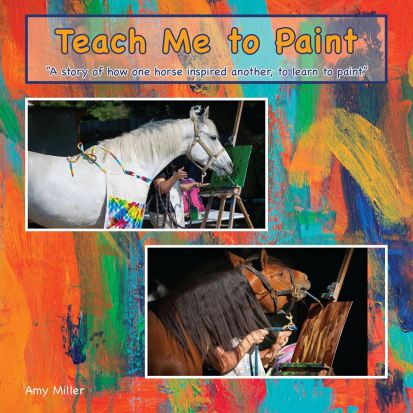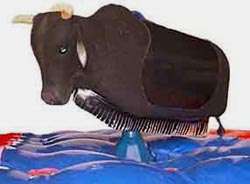While I have been in my lessons with horses, I have been learning so much about how we should even allow the horse to accept us as a trainer.

Working with Cheyenne is fun, but a definite learning experience. (Photo By Randy Kroll)
I was working with Cheyenne yesterday, we were in the small indoor arena and I had to go somewhere quickly so I allow her to walk around. When I came back, she was looking out of the half door outside to the back where all the other horses were. She glanced back at me, but then turned her head back lazily to watch life outside the window. I simply gave her the cue, glaring at her hind legs, then lifting the carrot stick. This tells the horse to turn and face me. Cheyenne simply turned around and nonchalantly ambled in my direction.
To reward her for this, I turn sideways and look away from her to take the pressure off of her. I remembered what I was taught just recently by my instructor, that before we work with horses we need to get their permission and allow them to let us know if they accept us as trainers. So I raised my hand, palm down, up to the side then waited to see if she would touch my hand. It took her about 3 minutes before she actually touched my hand and accepted my leadership.
I am finding horse training in the natural horse method to be a much better form. We are not looking to train our horses to work because they have to, but more because they want our companionship. That is why we learn to deal with the horse we have today. I have said this many times to my instructor, “but my horse did it so well yesterday, I don’t understand why she is not performing that way today.” The answer is that we have to deal with the horse they are today. Your horse could be bold and brave one day and flighty the next. I have definitely seen this in my horses. So we work with the emotion they have that day. If we have a flighty horse and we wanted to work on trail riding but our horse is having a hard time accepting the horse trailer, we should take our time and help her get over her fear of the horse trailer and maybe we won’t be able to ride on the trail today. But instead we should think about it in a way that we helped our friend deal with their own anxieties. Eventually, this horse will do anything for you because they trust you with their life. This is because we allow them to tell us how they are feeling from day to day. We need to go as if we are going to work with our horses in areas where they need help in. Don’t be so much of a direct line thinker and listen to our horses, they will let you know where your focus should be.
I have been without a computer for months now, I am not sure exactly how many months but I missed writing about what I have been up to with my horses and all their tricks and natural horsemanship. We were able to finally get our computer fixed by my nephew, and now we have a computer again. I am so excited to be writing blogs again!
Meanwhile, without a computer, I kept working on my horses and minis. I have had birthday parties where I would take the horses or minis and have them go through all their tricks and then we would give pony rides or rides on the horses. I have had quite a few this year thanks to being on gigsalad.com where I could put my information up and get clients who want pony parties and then I would usually sell myself even more by letting them know that my horses or minis can do tricks as well as just being a riding pony. Sometimes they wanted that, sometimes they would find someone else they wanted that they thought was cheaper. I know one thing for sure — in order to sell myself, my price has to be the same as a regular pony party because people don’t understand how much fun it is to watch horses or minis do lots of spectacular tricks. But I have had no complaints but usually a lot of compliments as well as some nice financial tips.
Yes, it is nice to be able to type all this out for you to see what is happening with my horses and me and hopefully help you in somehow learning what I have been learning, and I’m still learning from the horses. There is a lot more that I need to know about horses. I really don’t think we ever stop learning.








 It has a story line that I have experienced with my horses that I think kids — and even adults who are horse enthusiasts — would love. It is about the time when I was so diligently teaching my one horse Cheyenne to paint. However, off to the side was my older mare Gypsy, every day, watching this project going on involving teaching Cheyenne to hold the brush and to be able to sweep her head in different directions with the brush. So all the time this was going on, Gypsy watched. Finally, I got a glimpse of Gypsy starting to fuss in a way that brought me to the conclusion that maybe she wanted to paint. Can horses learn from each other to do something?
It has a story line that I have experienced with my horses that I think kids — and even adults who are horse enthusiasts — would love. It is about the time when I was so diligently teaching my one horse Cheyenne to paint. However, off to the side was my older mare Gypsy, every day, watching this project going on involving teaching Cheyenne to hold the brush and to be able to sweep her head in different directions with the brush. So all the time this was going on, Gypsy watched. Finally, I got a glimpse of Gypsy starting to fuss in a way that brought me to the conclusion that maybe she wanted to paint. Can horses learn from each other to do something? My instructor, Jolene, has a large, life-sized plastic or metal bull on her property. It is a nice item to use with horses needing to become less fearful of lifelike animals. I had Cheyenne approach it. It was a fearful thing for her. She was wondering, what was that creature and was he planning to eat her up? We would have her approach and retreat while I was holding on to the end of a 12-foot line for my safety, while she navigated through this thought process. I would ask her to approach it by looking directly at it and pointing a finger while asking her with the carrot stick to approach it. I have to remember to reward the slightest try from her. She looked at it and perhaps blew through her nose at it. That was a slight try, so I rewarded her for that by relaxing the pressure and then backing her to release the pressure even more.
My instructor, Jolene, has a large, life-sized plastic or metal bull on her property. It is a nice item to use with horses needing to become less fearful of lifelike animals. I had Cheyenne approach it. It was a fearful thing for her. She was wondering, what was that creature and was he planning to eat her up? We would have her approach and retreat while I was holding on to the end of a 12-foot line for my safety, while she navigated through this thought process. I would ask her to approach it by looking directly at it and pointing a finger while asking her with the carrot stick to approach it. I have to remember to reward the slightest try from her. She looked at it and perhaps blew through her nose at it. That was a slight try, so I rewarded her for that by relaxing the pressure and then backing her to release the pressure even more. If I see someone who doesn’t have quiet hands and they have put a harsh bit on the horse, I think that is abusive simply because they have a bit on that is too harsh and they, the rider, does not know the correct way to use that bit. The horse then has his mouth gaping wide open, wishing they could get away from the pain. A large curb bit with a strap under their chin causes the large curb to go into the horse’s mouth and the chin strap pinches the mouth shut, which makes it even more painful since they can’t escape the pain. I am not saying that no one should use them, but these riders should have very soft hands. My father has soft hands, so he could use this bit and not hurt the horse.
If I see someone who doesn’t have quiet hands and they have put a harsh bit on the horse, I think that is abusive simply because they have a bit on that is too harsh and they, the rider, does not know the correct way to use that bit. The horse then has his mouth gaping wide open, wishing they could get away from the pain. A large curb bit with a strap under their chin causes the large curb to go into the horse’s mouth and the chin strap pinches the mouth shut, which makes it even more painful since they can’t escape the pain. I am not saying that no one should use them, but these riders should have very soft hands. My father has soft hands, so he could use this bit and not hurt the horse. I also hate it when riders use aids that are too much aid or signal to the horse when it could have been softer, too harsh of a bit in inexperienced hands, or too large spurs being used harshly by, again, inexperienced riders, where people also use whips in excessive and abusive ways other than use as an aid or and extension of their arms. You get where I am going here.
I also hate it when riders use aids that are too much aid or signal to the horse when it could have been softer, too harsh of a bit in inexperienced hands, or too large spurs being used harshly by, again, inexperienced riders, where people also use whips in excessive and abusive ways other than use as an aid or and extension of their arms. You get where I am going here.